9 must-have e-marketing techniques in e-commerce
Use this seven-minute read to get savvy and take action with nine must-have e-marketing techniques in e-commerce.

Use this seven-minute read to get savvy and take action with nine must-have e-marketing techniques in e-commerce.

Overnight marketing successes in e-commerce are rare.
As much as we’d like to write about a straightforward growth hack that translates into instant sales, the truth is that it takes time.
Not only does it require patience, but you also need a combination of different tactics at your disposal.
From easy-to-introduce “also bought recommendations” to more complicated product filtering projects, the following nine must-have digital marketing techniques cover different growth levers for your e-commerce store.
Without further ado, here they are.
Checkout payment options are an essential factor in finalizing e-commerce sales. As the latest research report by e-commerce payment provider PPRO shows, 42% of U.S shoppers stop purchasing if their favorite payment method isn’t available.
Interestingly, the survey also found that 29% of people are interested in installment payment options. For stores with high price-tag items, the impact of installment payments is likely to be even higher.
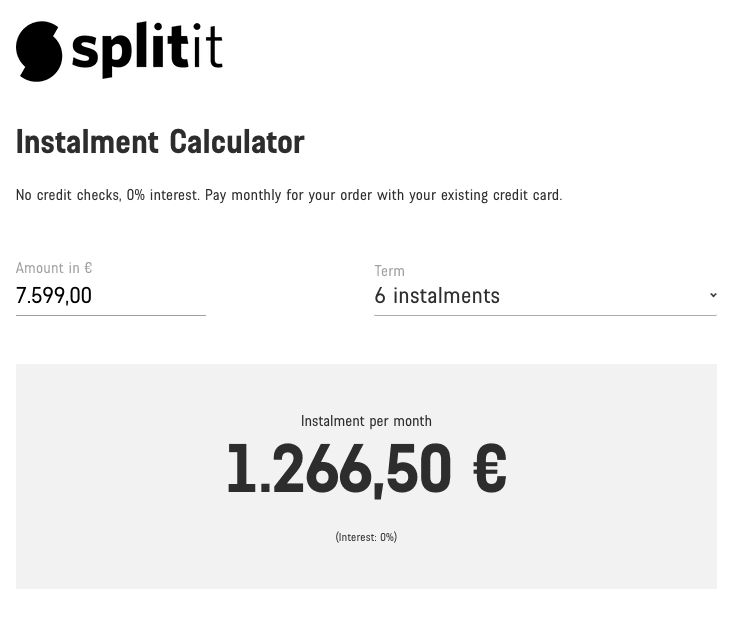
One such solution that supports this, Klarna, states that it can increase the average online store’s orders by 30% and the average spend by 34%.
If you’re doubtful, here’s an online business selling a course with three payment options: a lump sum, four payments of $225, or ten payments of $99.
Not only have they won 27% more customers since they began offering monthly payments, but 90% of their customers who choose to pay monthly choose the ten-payment plan, even though it costs $100 more than the four-payment plan.
90% of customers willingly pay more in total, just to get a lower monthly payment.
The reason that physical retail has stuck around so long is that people like to try things out before they buy them.
That’s where interactive product visualization comes in. These 3D product experiences allow consumers to explore products online as though they were in a store. Here’s an example of how it works on the Converse store.

Businesses can display their products through a 3D viewer on their websites so that customers can see all product attributes clearly–including textures, sizes, colors, and more.
Even e-commerce product videos have evolved to be more engaging. What was once similar to an infomercial has transformed into an immersive, 360-degree online shopping experience.
It’s no secret that visuals make or break your online brand, customer experience, and sales. If you want to sell more products online, investing in product visualization is a good start.
We’ve written before about the emergence of conversational commerce and how it’s an opportunity for DTC brands.
If you haven’t heard the term before, conversational commerce makes it possible for customers to get personalized advice, information on products and services, and place orders, and complete transactions–all from messaging apps.
It means that businesses now need to communicate with the same ease, practicality, and conversational style that their customers do.
Contrary to popular opinion, conversational commerce doesn’t require an expensive AI-powered chatbot. You can simply text-enable your existing toll-free number and give customers the option to text your company questions.
Here’s an example of one DTC brand’s conversational experience: “Burrow House from home.” The DTC furniture brand lets you book a 15-or-30-minute appointment with one of the company’s trained, full-time design experts.

When testing 19 sites and benchmarking 50 major e-commerce sites on product lists and filtering usability, the team over at Baynard Institute found that 84% of the sites had a mediocre or poor product filtering experience.
This points to a significant opportunity for brands that can add better filtering options to their site. The team behind the research suggests creating specific filters for the most popular categories that go beyond color or size.
Their advice: think of what people want to differentiate between the various items if you want the best possible e-commerce website design.
Improving your filtering system can significantly affect how many products consumers view and ultimately buy. The reason behind this is simple–when product filters are implemented well, customers can look at the different products you offer and specify it to the few ones that match their needs and preferences.

Source: Business 2 Community
While product recommendations on product pages are not an incredibly innovative e-marketing technique in e-commerce, they’re an essential part of your cross-selling strategy. It’s also one that too few brands incorporate into their product pages.
Here’s an example from the sports store Decathlon.
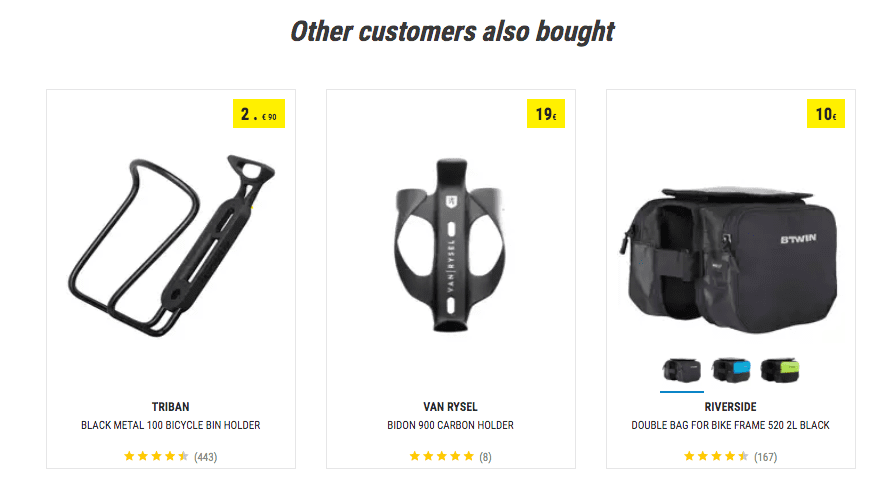
For example, when a customer views a pair of pants, the products frequently bought together with it may be shoes or shirts that go together. People are likely to buy things that match aesthetically.
Even if you don’t include it on your product page, you can email customers with your recommendation, showing them cross-sale items they may want to come back and purchase.
Implementing pop-ups on your e-commerce website has to fulfill a goal: otherwise, it’s unnecessary noise that’ll distract your visitors away from your content.
One of the most effective ways to use pop-ups is to offer your users a small percentage discount. Not only are you collecting phone numbers or emails of potential customers, but you’re providing an incentive to make the leap and become a customer.
This tactic helped Toroe Eyewear increase the conversion rate on its website by 200%.
Using our Mobile Sign-Up Widget, the sunglass brand offers website visitors a 10% discount if they text in the keyword “HELLO.” (An SMS keyword is a word or phrase that customers text to your number to receive future text messages.)

When customers click the button within the pop-up, their text app opens with the prefilled keyword and phone number. All they have to do is tap send.
Amazon, Walmart, and Target aren’t just popular retailers—their websites also serve as resources. Thousands of people flock to these sites daily to research products by reading customer reviews.
Simply put, more ratings and product reviews mean more customers and more revenue.
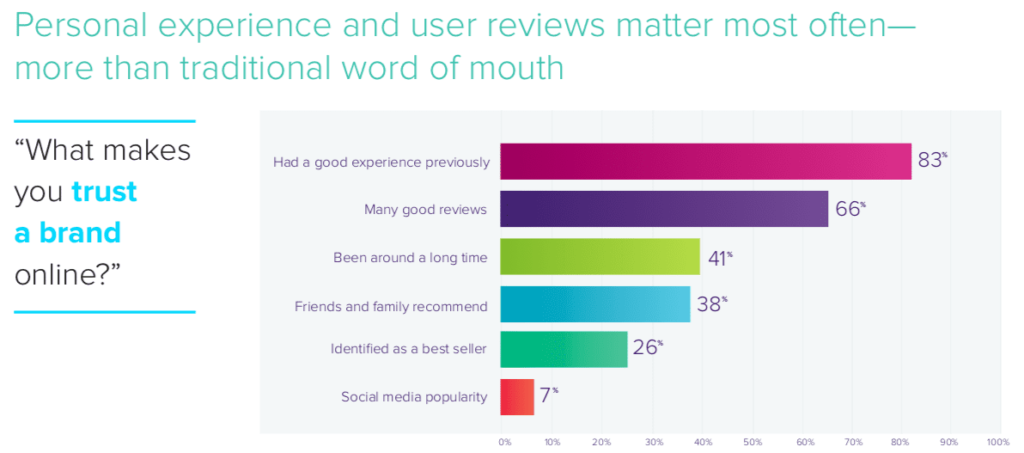
Source: Salsify
Some brands choose to send review requests by email, but the 98% open rates of SMS make it an unrivaled channel for collecting your customer’s feedback. We’ve written extensively about using SMS for review requests and even provide examples of good customer reviews.
They’re both worth reading, but the quick takeaway is that for generating reviews on your product page, you can offer things in your text messages like:
When it comes to buyer psychology, there’s no better way to encourage sales than invoking FOMO—the fear of missing out. By playing into people’s desire to be included, you boost your buyers to make more purchases.
So if you can highlight how scarce your product or service is—or at least create the illusion that it’s about to run out—you can drive people to click the Buy button before somebody else does.
One place to do this is on the checkout page. As OptiMonk points out, when customers see the total cost of items in their cart, it can cause “sticker shock.” By reminding shoppers that individual prices or stock are only available for a short period, you can help them overcome this.
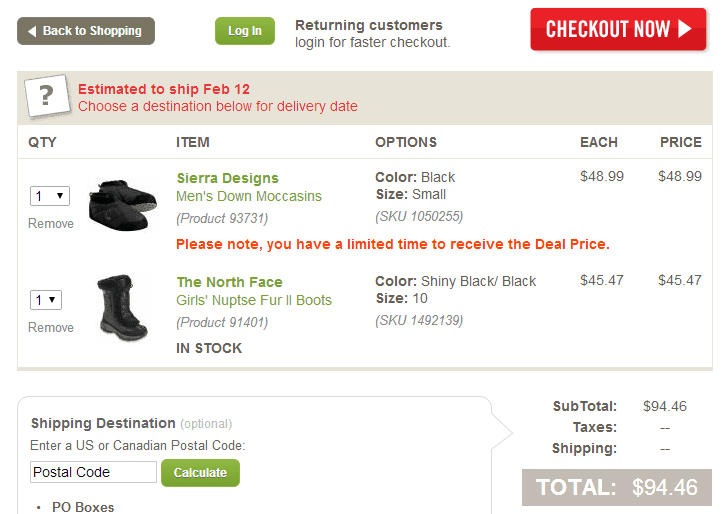
This article from CoreDNA provides 23 additional tactics to create urgency and grow your e-commerce conversions.
Restock alerts are a revenue saver when you run out of a product or product variant. It’s much better than telling your customers that you’re out of stock, which directs them straight to your competition.
On the other hand, when you give customers the option to sign up for an alert, there’s a chance they wait around.
You can take this strategy one step further, and instead of sending customers back home empty-handed, guide them to a different product. For example, ASOS gives people the option to shop for other clothes from the same brand and other jackets.
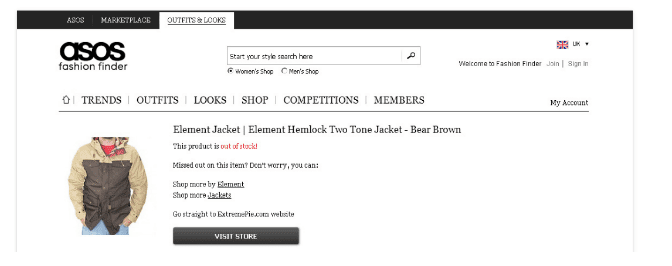
Source: Blue Stout
Here’s another example from the ASOS app, which provides you with the option to see similar items.

Source: ECOMITIZE
It’s an excellent way to get frustrated visitors back on track and improve your sold-out-page conversions.
Sometimes in the quest to make a significant breakthrough in our marketing plan, we lose sight of the smaller steps we can take to make more immediate improvements.
As you can see, using a mixture of tactics, you can have a major impact on your e-commerce business.
Drew Wilkinson is the Head of Marketing at SimpleTexting. Drew has more than a decade of experience managing successful integrated marketing programs to build brands, raise awareness, and generate demand.
More Posts from Drew WilkinsonUsing SimpleTexting’s Mobile Sign-Up Widget to advertise a 10% discount, Toroe Eyewear generated an extra $7,028 in store revenue in a month. That’s a 156x return on its text marketing channel.
ReadHow do you make your Black Friday SMS marketing strategy stand out from the competition? With these six tips and examples.
ReadStart a text marketing campaign or have a 1-on-1 conversation today. It's risk free. Sign up for a free 14-day trial today to see SimpleTexting in action.
No credit card required